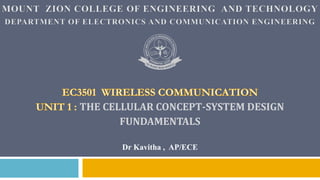
EC3501-WC.pptx
- 1. THE CELLULAR CONCEPT-SYSTEM DESIGN FUNDAMENTALS Dr Kavitha , AP/ECE
- 2. UNIT 1: THE CELLULAR CONCEPT-SYSTEM DESIGN FUNDAMENTALS 1.1 Introduction 1.2 Frequency Reuse 1.3 Channel Assignment Strategies- 1.4(a) Handoff Strategies: Prioritizing Handoffs, 1.4(b)Practical Handoff Considerations. 1.5 (a)Interference And System Capacity: 1.5 (b)Co-Channel Interference and System Capacity- 1.6 Channel Planning For Wireless Systems- Adjacent Channel Interference, Power Control For Reducing Interference, 1.7Trunking And Grade of Service. 1.8 Improving Coverage And Capacity In Cellular Systems: Cell Splitting, 1.9 Sectoring
- 3. UNIT 1: THE CELLULAR CONCEPT-SYSTEM DESIGN FUNDAMENTALS Course Outcomes: • Understand the concept and design of a cellular system.
- 4. UNIT 1: THE CELLULAR CONCEPT-SYSTEM DESIGN FUNDAMENTALS Previous Class: 1.1 Introduction 1.2 Frequency Reuse Today’s Class Outline: 1.3 Channel Assignment Strategies- 1.4(a)Handoff Strategies:Prioritizing Handoffs
- 5. Fixed channel assignment strategy Each cell allocated a pre-determined set of voice channels calls within cell only served by unused cell channels all channels used → blocked call → no service several variations exist Borrowing strategy- MSC allows cell to borrow a Voice Channel (that is to say, a FVC/RVC pair) from an adjacent cell donor cell must have an available VC to give
- 6. Dynamic Channel strategy Voice channels- not allocated permanently Each time call request is made Serving base station request channel from MSC MSC allocates frequency, If frequency is free Frequency reuse process will be done
- 7. Hand off Handoff: when a mobile unit moves from one cell to another while a call is in progress, the MSC must transfer (handoff) the call to a new channel belonging to a new base station new voice and control channel frequencies very important task → often given higher priority than new call It is worse to drop an in-progress call than to deny a new one
- 8. Contd.. Advantage: reduces call blocking (that is to say, it increases the trunking capacity), and increases voice quality Disadvantage: increases storage & computational load @ MSC requires real-time data from entire network related to: Channel occupancy Traffic distribution Radio Signal Strength Indications (RSSI's) from all channels
- 10. Contd.. Handoff Decision signal level decreases due to signal fading → don’t handoff mobile moving away from base station → handoff must monitor received signal strength over a period of time → moving average time allowed to complete handoff depends on mobile speed large negative received signal strength (RSS) slope → high
- 11. Contd.. Minimum useable signal level lowest acceptable voice quality call is dropped if below this level specified by system designers typical values → -90 to -100 dBm choose a (handoff threshold) > (minimum useable signal level) so there is time to switch channels before level becomes too low
- 12. Contd.. As mobile moves away from base station and toward another base station Handoff Margin △ △ = Phandoff threshold - Pminimum usable signal dB carefully selected △ too large → unnecessary handoff → MSC loaded down △ too small → not enough time to transfer → call dropped!
- 13. Contd.. A dropped handoff can be caused by two factors not enough time to perform handoff delay by MSC in assigning handoff high traffic conditions and high computational load on MSC can cause excessive delay by the MSC no channels available in new cell
- 14. Dwell time • Dwell time: the time over which a call may be maintained within a cell without handoff. • Dwell time depends on – propagation – interference – distance – speed
- 15. Contd.. • Handoff measurement – In first generation analog cellular systems, signal strength measurements are made by the base station and supervised by the MSC. – In second generation systems (TDMA), handoff decisions are mobile assisted, called mobile assisted handoff (MAHO) • Intersystem handoff: If a mobile moves from one cellular system to a different cellular system controlled by a different MSC. • Handoff requests is much important than handling a new call.
- 16. Practical handoff considerations • Different type of users – High speed users need frequent handoff during a call. – Low speed users may never need a handoff during a call. • Microcells to provide capacity, the MSC can become burdened if high speed users are constantly being passed between very small cells. • Minimize handoff intervention – handle the simultaneous traffic of high speed and low speed users.
- 17. Contd.. • Large and small cells can be located at a single location (umbrella cell) – different antenna height – different power level • Cell dragging problem: pedestrian users provide a very strong signal to the base station – The user may travel deep within a neighboring cell
- 19. Contd.. • Handoff for first generation analog cellular systems – 10 secs handoff time – is in the order of 6 dB to 12 dB • Handoff for second generation cellular systems, e.g., GSM – 1 to 2 seconds handoff time – mobile assists handoff – is in the order of 0 dB to 6 dB – Handoff decisions based on signal strength, co-channel interference, and adjacent channel interference.
- 20. Contd.. • IS-95 CDMA spread spectrum cellular system – Mobiles share the channel in every cell. – No physical change of channel during handoff – MSC decides the base station with the best receiving signal as the service station
- 21. Types of Handoff Types: Hard handoff: “break before make” connection Intra and inter-cell handoffs
- 22. Types of handoff Soft handoff: “make-before-break” connection. Mobile directed handoff. Multiways and softer handoffs
- 24. Summary : Channel Assignment Strategies- Handoff Strategies: Prioritizing Handoffs